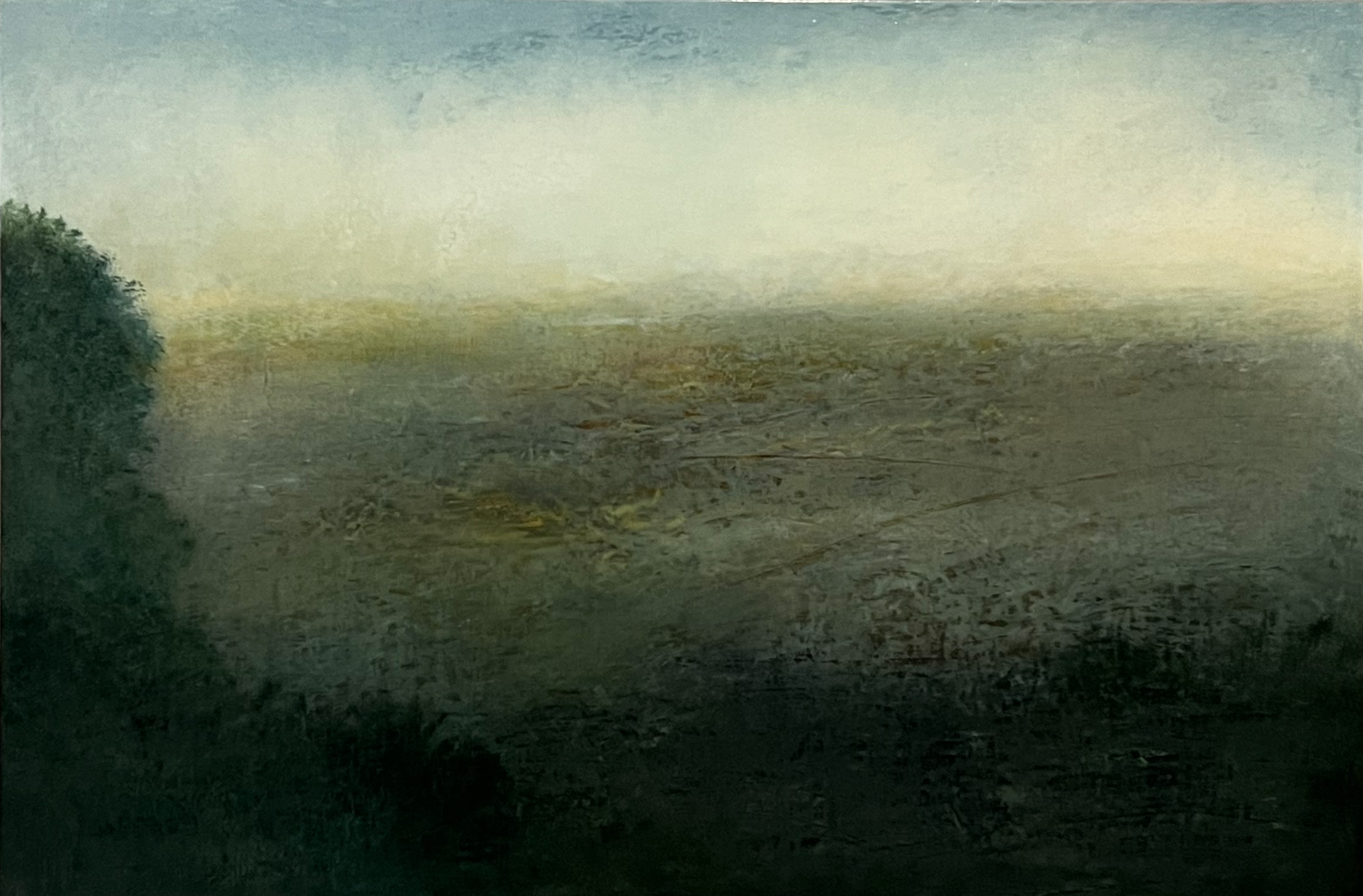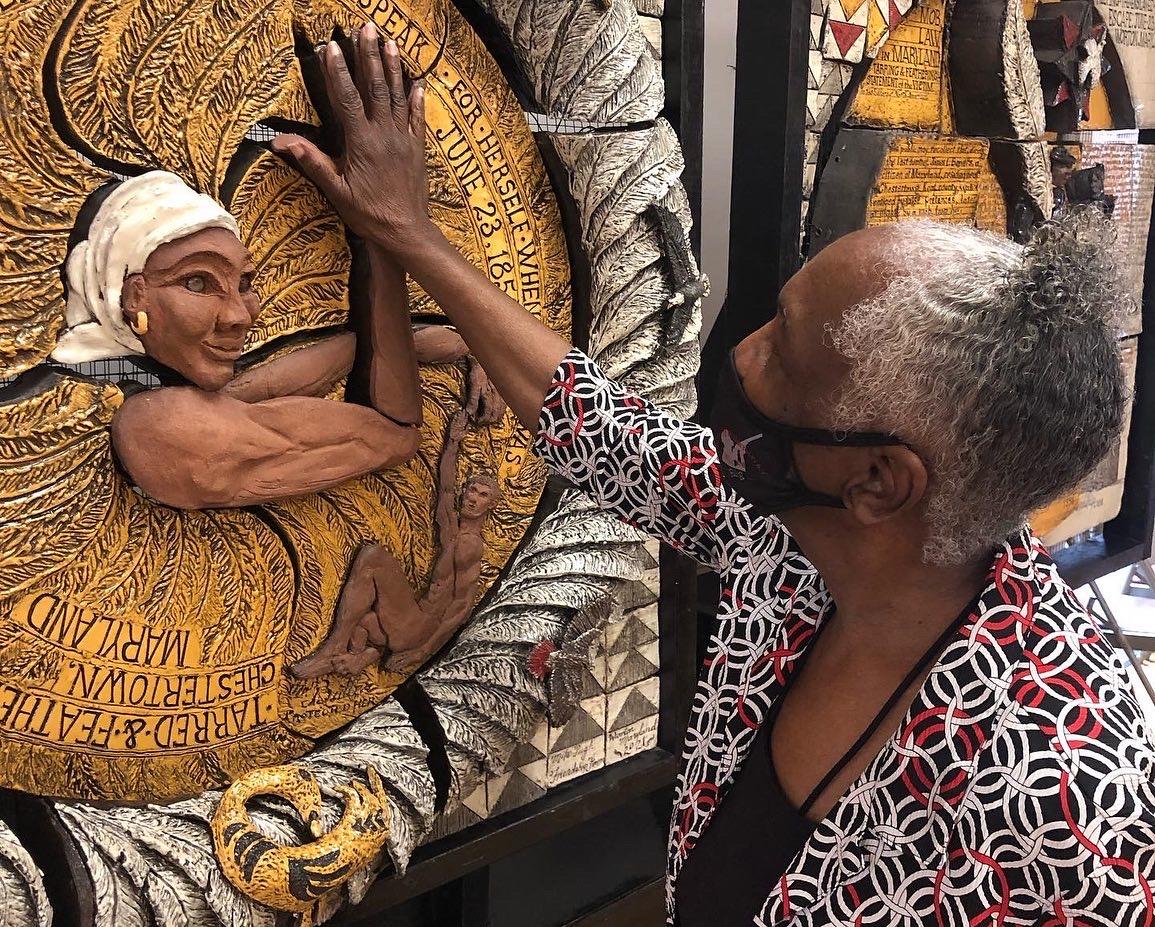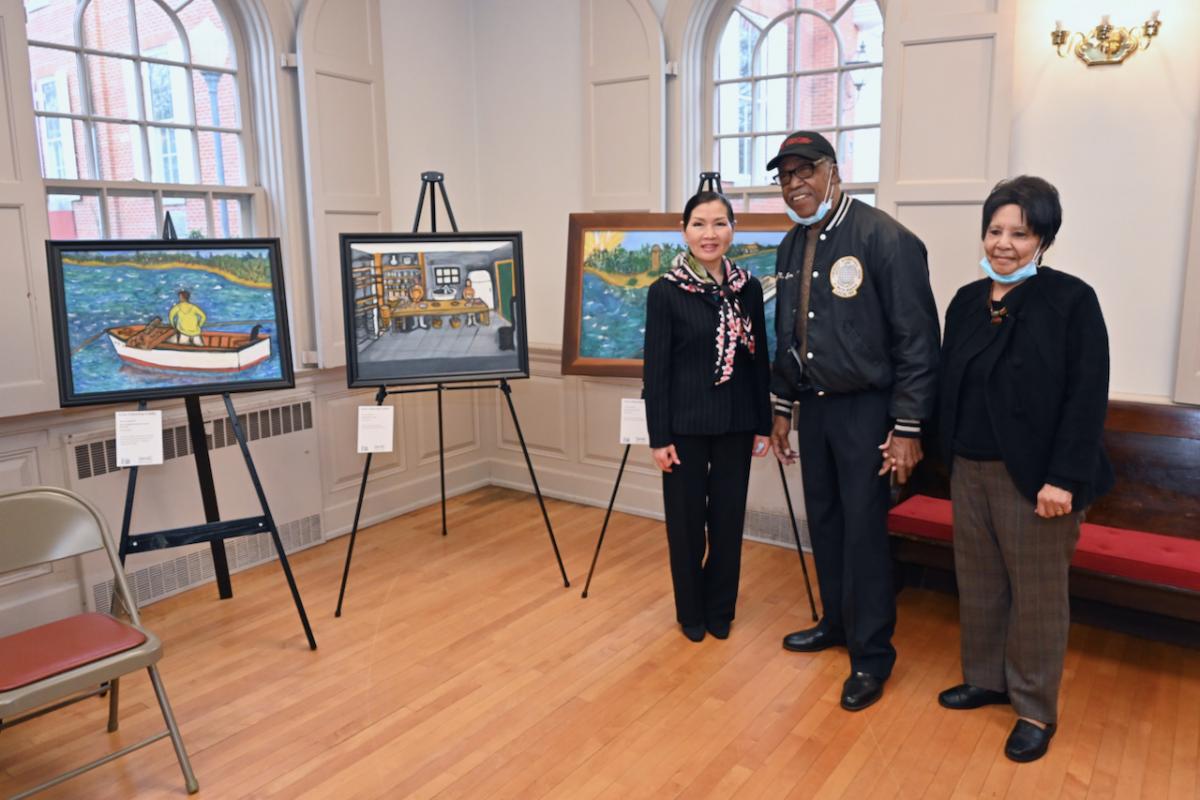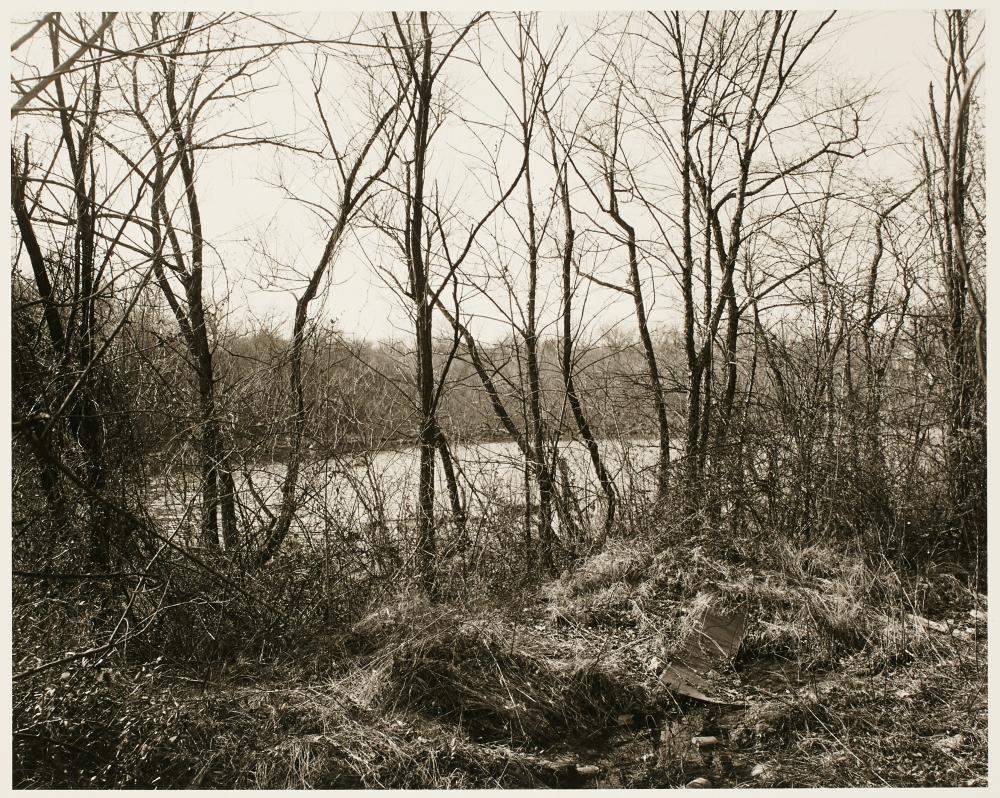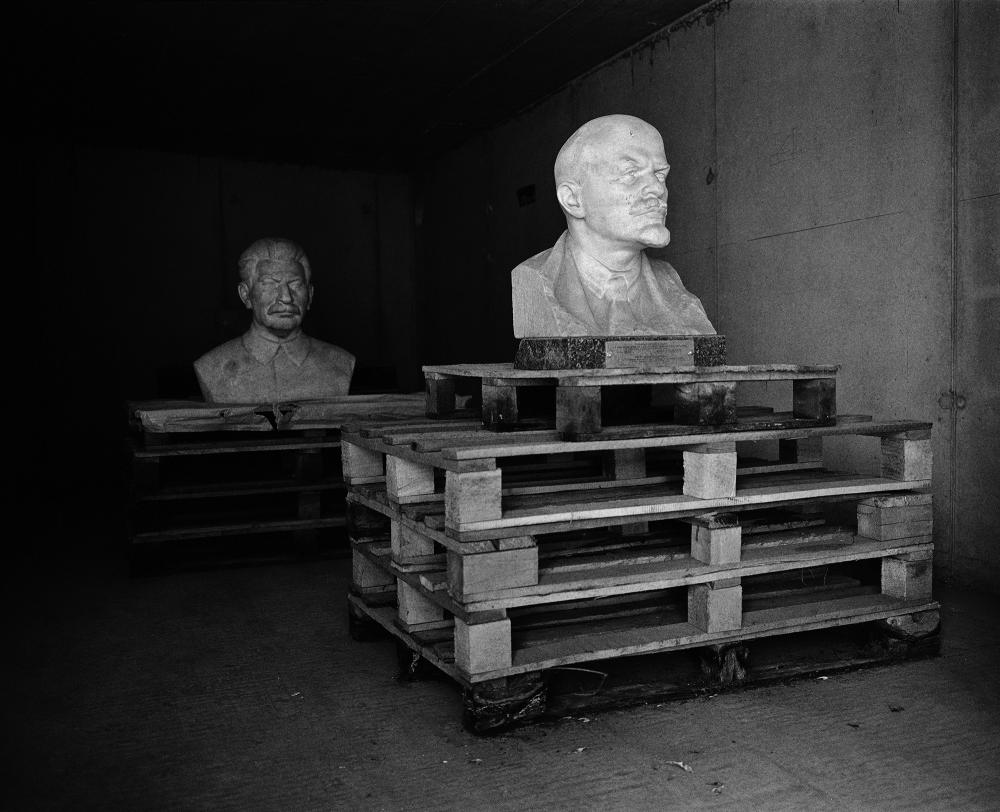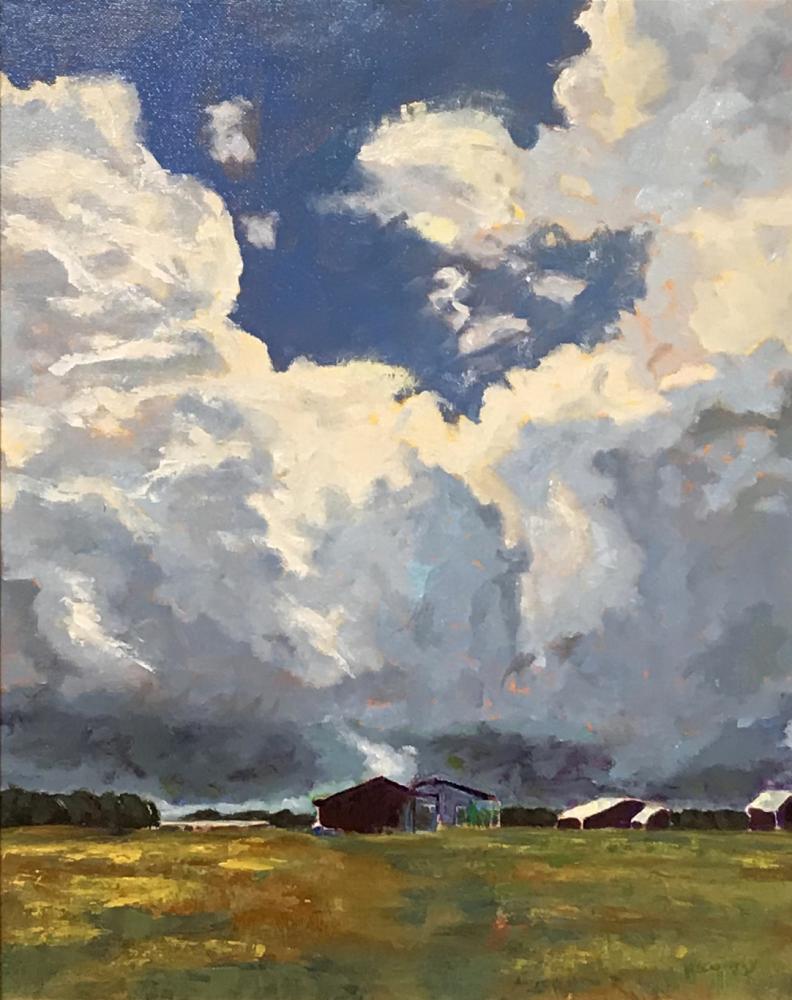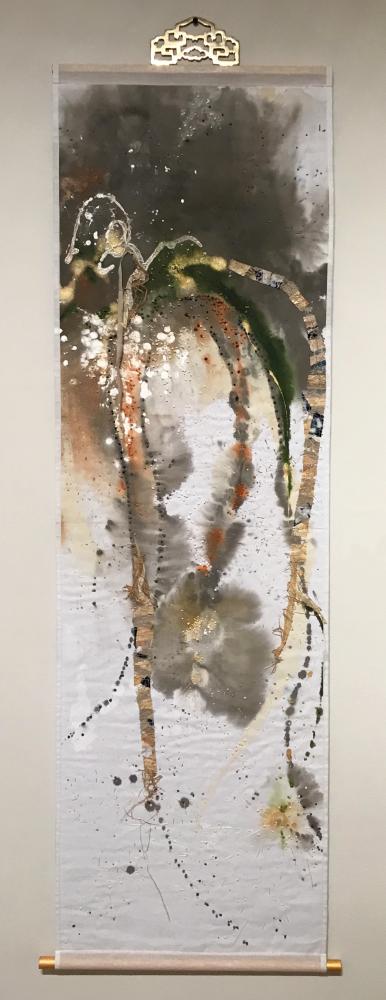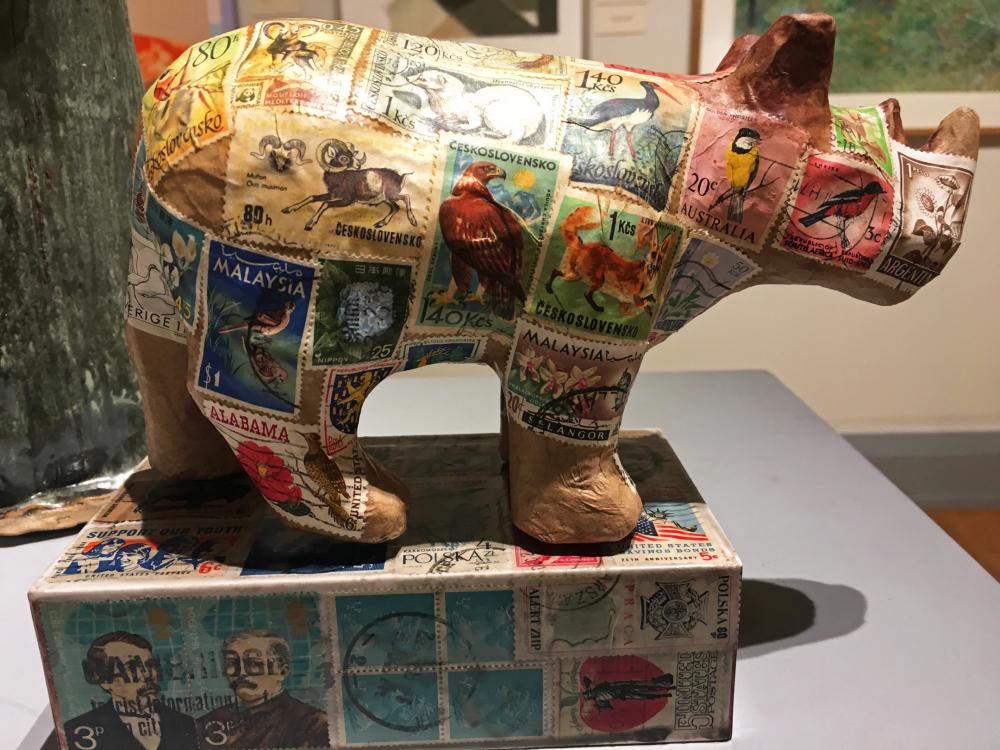 The deep, rich colors and textures of Grace Mitchell’s oil paintings will draw you in, but it’s often the title that sets you thinking. Interweaving layers of color glow through the marsh grasses in her newest series “Watershed Assessment.” You could get lost in the sheer beauty of these paintings with their glints of tidal water and shadowy mountains looming in the distance, all saturated with a moist, misty atmosphere that seems to glow with fecundity.
The deep, rich colors and textures of Grace Mitchell’s oil paintings will draw you in, but it’s often the title that sets you thinking. Interweaving layers of color glow through the marsh grasses in her newest series “Watershed Assessment.” You could get lost in the sheer beauty of these paintings with their glints of tidal water and shadowy mountains looming in the distance, all saturated with a moist, misty atmosphere that seems to glow with fecundity.
But the title gives pause. These lush, luminous landscapes are meant to be “assessed,” and careful observation finds them full of scars and flaws. Their layers of luscious colors have been scraped raw and sanded almost to nothingness, drips and coagulations of paint stain the surface like rain on a window, everything seems in a state of flux. This marsh that Mitchell has chosen to paint is a transitional place where life is born of water and each element is held in an ever-changing fragile balance.
“Watershed” is an inspired title for this show and carries a double meaning. Every mountain, forest, marsh and sea that Grace Mitchell paints is part of a watershed. Most of us don’t tend to think of that when we look at a landscape, but these paintings make it clear that water connects all things in nature, from the massive clouds Mitchell paints towering over verdant plains and forests to the mists and rain that feed her flowing streams, brooding marshes and restless seas. Time after time, she traces the cycling of water from earth to sky and back again and in so doing, conjures a potent analogy for the complex interconnections that make life on earth possible.
Here, the other meaning of “watershed” comes to the fore. As temperatures warm, wildfires rage and massive storms sweep across the land, there’s no denying we are in a watershed moment. There is no longer any doubt that climate change is happening and happening fast thanks to our continuing use of fossil fuels. Where we go from here is our collective choice.
 An art gallery may seem an unlikely place to be confronted with this issue, but Mitchell’s show inspires its consideration. Heart-wrenchingly beautiful, her paintings invite you into a haunting mixture of darkness and luminosity that permeates these scenes so deeply that the vitality of the living land is palpable. Mountains both soar and crumble before your eyes as light filters through the mists swirling around them. Trees simultaneously form and dematerialize in strokes and smears of paint while the marsh grasses surrounding them dissolve into drips of paint that melt into the water of a tidal pool. All is in flux and every detail is related to what’s happening around it.
An art gallery may seem an unlikely place to be confronted with this issue, but Mitchell’s show inspires its consideration. Heart-wrenchingly beautiful, her paintings invite you into a haunting mixture of darkness and luminosity that permeates these scenes so deeply that the vitality of the living land is palpable. Mountains both soar and crumble before your eyes as light filters through the mists swirling around them. Trees simultaneously form and dematerialize in strokes and smears of paint while the marsh grasses surrounding them dissolve into drips of paint that melt into the water of a tidal pool. All is in flux and every detail is related to what’s happening around it.
The artist’s hand is everywhere in evidence in her sweeping gestures, daubs and broken strokes of paint, yet these paintings are smooth as glass and have an inner radiance akin to polished marble. Borrowing her technique from traditional landscape painters, Mitchell repeatedly applies thin layers of paint, sanding each one back then painting again. Fields of color and fascinating details are exposed, then half hidden, then exposed again so that the paintings reveal their own history of making, much as landscapes reveal the effects of weather and geological time.
There is no doubt about the aliveness of every aspect of these landscapes and the seamlessness of the interdependence of each element. With a bracing sense of awe, each of these paintings tells a story of earth and its predicament. They pull on your heartstrings and make you long for the vitality of the ecosystems that form our landscapes to survive and flourish.
 Recalling the atmospheric depth and majesty of traditional landscape paintings, particularly of 19th-century Romanticism, as well as the deeply spiritual qualities of Chinese mountain and water tradition, Mitchell makes geological time palpable, yet there’s also a sense of the momentary, a feeling that you are witnessing something in the process of continual change.
Recalling the atmospheric depth and majesty of traditional landscape paintings, particularly of 19th-century Romanticism, as well as the deeply spiritual qualities of Chinese mountain and water tradition, Mitchell makes geological time palpable, yet there’s also a sense of the momentary, a feeling that you are witnessing something in the process of continual change.
Art is always at the forefront of cultural change. From Goya to the Impressionists, and from Picasso to Rauschenberg to Keith Haring, artists have opened our eyes to new ways of seeing and understanding. Perhaps because artists must develop keen skills of observation and awareness in order to do their work, they are more attuned to sensing change long before others do. Certainly, with her flair for capturing both the beauty and distress of the earth, Mitchell falls into this category.
 In August, she and I carried on an almost daily email conversation about her work, our shared concerns about environmental degradation and climate change and how art might function to stimulate creative ways of adapting. Here are some excerpts:
In August, she and I carried on an almost daily email conversation about her work, our shared concerns about environmental degradation and climate change and how art might function to stimulate creative ways of adapting. Here are some excerpts:
MM: From the start I want you to know how glad I am for this opportunity to focus on your work. For some time now, I’ve been struggling with the role of art in reawakening people to a sense of awe and wonder, and how to kindle curiosity about what creative possibilities may be available for healing our relationship with the earth. These are ideas I see you developing in your paintings.
GM: Most of my work has an implied message, that of interdependence in the natural world and threats to that and to the future of life on earth. The future prospects of sustainability depend, in part at least, upon comprehending these relationships and adapting human behavior to them. Recently, I did several paintings of gardens, an idea that was inspired by the work of entomologist Doug Tallamy, so the gardens I choose are the gardens of the wild with their mix of native plants and trees, rather than our standard suburban flower patches.
MM: Tallamy’s warnings that wildlife populations are in decline largely because the native plants they depend on are disappearing are something I first learned about from Adkins Arboretum here on the Eastern Shore. Many of my garden plants came from its native plants sales, and it seems there’s a surge in people working to restore habitats by gardening with native plants.
GM: Yes, many people are practicing a form of home gardening which endeavors to replicate native conditions and incorporate some ancient wisdom into the practice of gardening to encourage, rather than kill vital insect, bird and animal populations which are rapidly declining due to agribusiness, development pressures and yes, even suburban gardens.
MM: You’ve written that you see the garden as a source of hope and regeneration. I think that’s so true, both in terms of grassroots conservation and for individual gardeners like you and me. Last winter, I had a bout of Covid with fatigue and inflammation that went on and on. It only let up when I started to work in the garden for at least a little while every day. That felt to me like a direct experience of the healing power of earth.
GM: I certainly agree that gardening helps, but I must admit that the increasing heat and humidity of our summers added to the rampant increase in invasive plants, as well as the ongoing problem with tick-borne diseases have made it harder to enjoy! But even all of that does help put things into some perspective, right? One is forced to confront serious issues even whilst pulling the weeds!
MM: It’s a paradox! On one side, gardening always lifts my spirits but on the other, I’m constantly noticing worrying changes. We used to have swarms of butterflies and bees in our garden rather than the few we see now. The huge decreases in bird and insect populations scientists are warning of are obvious right in our garden beds. These are all issues stemming from the effects of climate change.
GM: A great many origin stories tell of folks once living happily in a primordial paradise, a lush garden of peace and plenty where toil, want and conflict were unknown. But, as with the Garden of Eden, the stories often report the end of this paradisal existence due to human folly.
MM: The great beauty of your paintings does conjure a sense of paradise, even a sense of the sacred.
GM: How beauty is defined has changed with time and place, but the elusive concept has been with us, and closely associated with ideas of art, for thousands of years. The artist/activist Theaster Gates has written that “At every level of the human experience, we are looking for the beautiful, something that gives priority to our souls…. We drink in nature, we yearn to commune with the beautiful, we crave the sublime….” He feels that being around beautiful things can actually alter the way humans act.
MM: It seems to me that a great part of beauty’s power is to give people joy and a sense of harmony and well-being. In your paintings, it offers an enticing invitation to look more and more closely and discover the surprising colors, textures and plays of opacity and translucence. Looking closely reveals all this evidence of time and change, injury and adaptation that shows through the many layers of paint.
GM: I think that visual art, or at least what I do, aims to create objects of beauty that enrich human lives in some way, that when successful perhaps enlighten, inspire, uplift, or otherwise point to something “beyond” the quotidian cares of the world.
MM: Years ago, I reviewed Ellen Dissanayake’s book What Is Art For? for an art magazine. Her premise is that art denotes particular things as special, as socially important and thus serves an important cultural and evolutionary function. I think that the intense beauty of the landscapes in your paintings denotes them as special.
GM: The beauty of nature/land has inspired so much art through the ages, up to and including some of the modern abstract painters who still claimed nature as their muse. I grew up with that love of the land and continue to cherish its beauty and hope to be able to share the feeling with others. So many today are separated from the natural world to the point that they can lose touch with it. The paintings ask people to stop, look and reconnect—and hopefully to really see and feel.
MM: That’s so important! We’re usually too busy (or at least think we are) to look around, to be aware of the environment we’re living in. It’s a cultural failing, and I think it’s part of why young people are experiencing so much depression and desperation. Between the rigid schedules of activities kids are required to keep and the fear of allowing them to go outside unsupervised, they rarely get a chance to connect directly with nature.
GM: I think the lack of contact with the natural world is bound to have an impact on the minds of kids today, especially since it comes together with increased exposure to virtual media. Certainly that close contact with the sights, sounds, feeling of being in the natural world in the early years can be formative—the brain programmed in a certain way that stays with you as you wander on through life!
MM: Although I wouldn’t categorize you as a “climate artist” in the sense of creating activist art, I think that experiencing art such as yours encourages people to pay attention to the natural world, maybe even with a sense of reverence, and to develop a deeper understanding of the environmental crisis and hopefully, a stronger commitment to addressing it.
GM: Right, we need to open both hearts and minds. And actually, I also see both as interconnected parts of the same system which can be touched by art.
MM: You brought my attention to another book, Conversations Before the End of Time, in which the art critic and teacher Suzi Gablik has a conversation with Dissanayake about the function of art in these times of ecological and spiritual crisis. They discuss Dissanayake’s theory about art as a behavior that helps define us as human, a biological urge that actually contributes to survival. At least in traditional societies, it’s a way of defining what’s special, what people need to care about. Defining and affirming those values helps to make a strong, resilient culture. She sees that as antithetical to the contemporary Western understanding of art as a kind of luxury item subject to capitalist values.
GM: Although our culture has thought of art as a “frill,” or as just another commodity, I hope there’s still space for art as a means of communication, inspiration and enhancement of human life.
MM: I see your work as being full of hope, even while it’s saturated with pathos and sorrow both for humanity and the earth. It seems to me that each of your paintings is a call to focus on what we need to care about, just as Dissanayake says. Your mountains may be weathering away but they still soar and inspire, and your waterfalls, pools and streams run with life-giving water. There’s a feeling of the sacred that tempers the pathos. So, facing both cultural malaise and ecological disaster, how do we maintain hope? You and I are both being confronted with the reality of rising sea level. I’m seeing it here on Maryland’s Eastern Shore and you’re it seeing around your home in a Hudson River village adjacent to the large estuarine Piermont Marsh and the source of inspiration for many of your paintings.
GM; Well, in terms of hope, I think we choose. And in so many ways, our marsh provides a metaphor for the times. It is a liminal space, a place in constant flux between land and water, fertile, full of life and potential, the breeding ground for many species and vital to the life of river and ocean. There’s a beauty and a mysterious quality here, but also somehow a sense of portent. For ages, people considered marshes to be wasteland and a great many of our marshes have been destroyed, lost to landfill and development. Science has since shown us the error in those ways and is taking positive steps to mitigate the damage. The Hudson River National Estuarine Research Reserve was formed to help protect and preserve remaining marshes of significance, including Piermont Marsh, and reserve them for research as well, finally recognizing their importance to the environment. Today, of course, the whole area is under a new threat from human-induced sea level rise, and we actually can’t be sure it will even survive. But a state-funded pilot project is now underway to stabilize the eroding shoreline and help preserve the marsh, so we hope for the best!
MM: That’s a great project, though as you say, sea level rise is already a given. The side of our yard here on the Chester River is bordered by a marsh that’s creeping slowly into our lawn as the river is getting higher. Our house, like many close to the water, was flooded by Hurricane Isabel 20 years ago. Ever since, my husband and I have talked about elevating the house above the floodplain. We just went through a long process of conferring with architects, contractors and county officials about the possibility, only to find out the cost is prohibitive.
GM: On the face of it, that’s very bad news about the house. But it might turn out to be for the best. That process is complicated and obviously horrendously expensive, and who’s to say what level of protection it ultimately offers. If current science is correct and the rate of warming and sea level rise is accelerating, then all the estimates of what the levels will be and when are going to have to be looked at yet again.
MM: One of the paintings in the show is called “Solastalgia,” which is a term coined by the Australian philosopher, Glenn Albrecht that refers to an increasingly common psychological distress suffered by those whose familiar environment has been dramatically changed, all too often by our changing climate. That’s the kind of distress I’m feeling as we see flood tides coming closer and closer to our house.
GM: This has been the hottest summer on record, and people are more widely acknowledging that climate change is real, but still we have no real solutions in the works. My daughter and I have had this conversation about Homo sapiens as a flawed/failed species—one that has irreversibly fouled its own nest and is destined for extinction.
MM: This is something that Gablik and Dissanayake discuss, and it both shocked me and made so much sense when Dissanayake talked about how we’ve created an unnatural “supermechanistic” environment that we simply can’t adapt to. We know in our hearts that our ways of living are unsustainable both in terms of our own psychological wellbeing and for the earth. When I fall into despair about the crisis that is already unfolding, I think of a stone I found along the river. It has tiny fossils of scallop shells and must date back to a time when the land where I live was part of the ocean floor. It comforts me to think that the earth is always changing and adapting, and that even if humans disappear, it will ultimately survive us, as it has survived countless cataclysms in the distant past.
GM: Homo sapiens have been around for the tiniest blink of the eye in terms of the existence of life on earth. The fossils you found convey a sense of the deep time of that existence and do help put things into perspective, don’t they? I have a slab of stone about a foot square I pulled out of a woodland stream in the Catskills that’s full of fossilized shells. I love looking at it and thinking about the time involved with the formation of that stone, the shells, the mountains.
MM: You sent me an article about Piermont Marsh titled “Why a Marsh” from the journal Places. It details the vital functions of the marsh for a host of species and gives a wonderful chronology of how it was formed and continues to change both through natural processes and human activity. What’s fascinating is how it’s all about interconnection. It reminds me so much of your paintings, that sense of being able to trace the many stages of creation both in the marsh and the painting process. And although it posits that the marsh may eventually be swallowed by the water again, it closes with the thought that that will change, too, and at in some distant time, green plants will again sprout from its mudflats. Of course, there’s no knowing whether humans will still be around by then.
GM: It is almost beyond our capacity to imagine, but it is possible that the species will become extinct if unable to evolve quickly enough to correct its ways. I think my paintings look at that underlying world which supports us and will quite possibly survive us and continue to exist for whatever follows us. So in that there is some hope.
MM: Yes, the thought that earth will continue to evolve is heartening, but it’s human nature to hope for more and I can’t help hoping that a collective survival mechanism will kick in and the sooner the better! And maybe art can be part of that. The biological urge to make art that Dissanayake talks about is something you and I have both felt from childhood. Being artists, it’s our way to explore the world and make sense of it. The more art shows us what we need to care about and the more it pulls on our heartstrings, the more chance there is that we’ll make the necessary changes to allow humanity and all the other threatened species to survive.
GM: Living here at Piermont, though I never do plein air painting and almost never even sketch, I do store up something from frequent walks around the village, including the changing effects of light, and carry it back to the studio. I guess it all goes into some kind of big stew that I access via a mysterious process that I’m not sure anyone can really explain! But the main thing is that at times it can be accessed and shared. And if and when that succeeds, perhaps there is passed along something of the enormous importance of that sense of being in nature that contemporary people have lost and must regain if we are to make it to the next level! I found a quote from William James that I’m going with for now: “I will act as if what I do makes a difference.” I think that answers the question about maintaining hope in these difficult times!!
“Watershed” will be on exhibit in the 203 High Street gallery. Hours at both the High Street and Cross Street galleries are Thursday, Friday – 11-4; Saturday 10-5. In addition, the Cross Street gallery is open Sunday 12-3. Private appointments may be scheduled at any time by contacting Carla Massoni. 410-708-4512
Mary McCoy is an artist and writer who has the good fortune to live beside an old steamboat wharf on the Chester River. She is a former art critic for the Washington Post and several art publications. She enjoys kayaking the river and walking her family farm where she collects ideas and materials for her writing and for the environmental art she creates, often in collaboration with her husband Howard. They have exhibited their work in the U.S., Ireland, Wales and New Zealand.
For additional information please visit www.massoniart.com.
